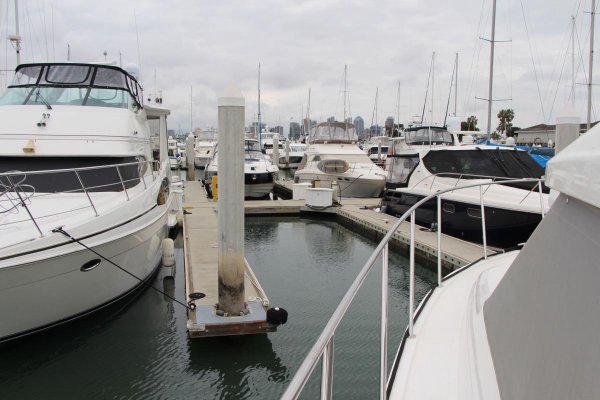On a rising tide, not necessarily a bigger than normal tide, we often get a current flowing at right angles across the dock, from port(shoreside) to starboard. You feel it when you start positioning to line up the berth, the boat won`t do what you are tell it. Doesn`t happen every time.
Seen from the dock, leaves in the water or mud stirred up by vigorous maneuvering rapidly disappear to starboard, with the boat. You no sooner get lined up to reverse in than you`re a boat stbd of your berth.
Only solution I can think of is, when the "I`m not doing that" boat behaviour starts, position the boat up current to port of the berth, wait for it to drift sideways and try to judge hitting reverse at just the right time to reverse into the berth. Thoughts and contributions welcome.
My first largish boat was a Uniflite 42 ACMY. I lived aboard near San Francisco's candlestick Park, a notoriously windy place where afternoon winds were commonly 30 kts. My slip was more or less perpendicular to the wind. While I avoided returning in the afternoon, I did find myself in uncomfortable situations, enough that it hindered use of the boat.
I can tell you from experience that the poke-and-hope method of side-sliding was not successful for me. Sideways momentum was just too great so landing was super sloppy. I'd try to stuff enough of the boat into the slip that I could just jam it home with tons of fenders. Was a great plan. Execution was awful.
Its hard for me to imagine your situation (Slip with piles? Fingers? Both sides or just one?), and I have no idea of your boat (single, twin, thruster, windage, etc), but if it were me on most boats, I would try to position the boat so I was working against the current - the side slide method has you working with the current. This might mean going past your slip and working back towards it. If there's an outboard piling or dock, tempting to land the aft quarter on it and pivot the bow, but if not successful, you will end up in a very difficult position pinned against neighboring slips/boats with no way to safely move. What's worse is there is a strong urge to power-up to extricate, which can be a very expensive and embarrassing urge as the stern swings into various fixed objects.
If the challenge is fairly moderate, and you can devise a reliable plan to use the current to your favor, do a ton of repetitions in practice during slack periods to build muscle memory. And practice aborting the landing to head back pit and reload. Honestly, backing a boat down a fairway scares me enough that I swear my DNA cell structure has been re-ordered a couple times, but sometimes that the way it has to happen. I never practiced it enough to get really comfortable with backing longish distances with obstructions on both sides.
But in the end, not all docking situations are solvable. If current is due to tide vs river, you may need to just wait it out. There is no magic bullet. If you don't have a thruster and this is common in your area, it might be a good investment, though even that is no guarantee if thruster is undersized or adverse conditions too great to overcome
In closing, I fancy myself a decent close quarter helmsman these days. I drove a 74-passenger dinner charter boat on SF Bay in the early 2000s for a while which really brushed up my docking skills - weather has to be really bad to cancel a run. Still, a couple months ago when I was in Ensenada and moved my Willard 36 from her berth, I totally misread the slight current (meaning I didn't even pay attention to it) and was about to be pinned. Thankfully, embarrassment was minimized due to mid week. And thankfully I had developed a good relationship with Victor, the dock worker who quickly came to my rescue.
EDIT - Bruce - on my PC I can see your picture with boat backed-in (not so on my mobile where I first responded). Boats pivot roughly 1/3rd way back from the bow, more or less beneath your feet on the flybridge. My first try would be to back towards your slip, but aim for the finger up-current, maybe even a little further depending on strength of current. You will want the stern of your boat close to your slip when you rotate to minimize the amount of time you're exposed to sideways current. My goal would be for the pivot point (beneath your feet) to line-up with up-current side of slip when your rotation is complete and you will indeed be crabbing slightly from left to right. Need to minimize this as best possible. It may not be pretty - practice, practice, practice. BTW - nice boat!
Good luck
Peter


